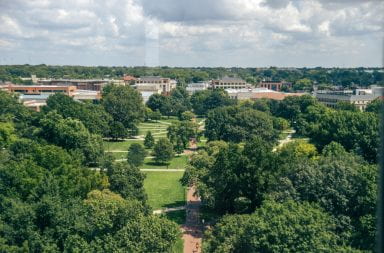On the merry-go-round of this late autumn quarter – with finals fast encroaching and legendary football victories abound – it’s easy for Ohio State students to overlook some of the changes going on around campus; changes that will primarily benefit the next generation of students.
So I’ll use this space to remind you that this month marks the campaign kickoff for renovations to our historical William Oxley Thompson Library. The mission statement voiced by those in charge stresses the importance of reestablishing the main library as the epicenter of campus life.
In my estimation, this is a wise decision by school officials. For all of its state-of-the-art facilities, OSU has been lacking a premier library for some time now. Don’t get me wrong, I have no qualms with our school’s collective libraries.
We have nineteen of them on campus, and that’s nothing to thumb your nose at. But by disseminating book stacks and multi-media resources across campus, the main library has lost a bit of its former prestige. Furthermore, the advent of Ohio Link, a network connecting all state school libraries, has also taken focus away from the grandeur of individual libraries and restructured it in the interstitial cyber-ethos between databases around the state.
But the upcoming renovations aim to channel the ambitious scope espoused by the man our library is actually named after. William Oxley Thompson, OSU’s president from 1899-1923, made the following statement: “The university has built on too small a scale. It is hoped that future buildings will have reference to future needs and provide liberally for the youth of the state.”
I think Thompson’s comments are a cogent rejoinder to all those who complain about rising tuition costs attributed to ambitious campus projects. Sure, most of us students will have already graduated by the time the main library and Larkins Athletic Center are complete, but students should take comfort and pride knowing school officials are constantly looking for ways to remodel and improve campus facilities. There’s everything to be said for admiring something larger than yourself.
Over the past three years, I’ve favored the main library over any other campus landmark, and this is coming from an avid college football fan. Maybe it’s because the library represents the intersection between our campus’ social and academic endeavors. After all, it sits at the head of the oval, presiding over all student traffic. At the beginning of each day, I subconsciously make a point of stepping foot in the library just to orient myself and check my e-mail.
But I’m always comforted by the library’s wealth of books, so much that I romanticize the very idea of the library all out of proportion. The 20th century, Argentinean writer Jorge-Luis Borges created fictional, labyrinthine libraries in several of his fictions that were worlds unto themselves. His libraries had hidden staircases that opened onto expansive parapets, as well as four-directional elevators. He dreamt that libraries contained an infinite number of books that encompassed all of man’s history, and no human experience could truly exist outside of the recordings in these timeless tomes. Borges’ library was simultaneously open and secretive, a shrine to humanity’s most public and private stirrings.
I like Borges’ conceit. Even if the upstairs book stacks in the main library have devolved into a hideaway for lovers’ trysts and hasty urination, I still haunt their shelves from time to time and marvel at the books I’m not enterprising enough to read.
I like to suppose there is some inscrutable soul toiling away quietly in an obscure chamber of our main library, making it his personal mission to appropriate all of the libraries’ intellectual riches for his own gain. That to me, seems like the consummate college career of the intellectual – not just the vocational-minded scholar. Maybe these upcoming renovations will spawn a new breed of book lovers and ambitious library-nesters.
Brad Peters is a junior in English. He can be reached for comment at [email protected].


